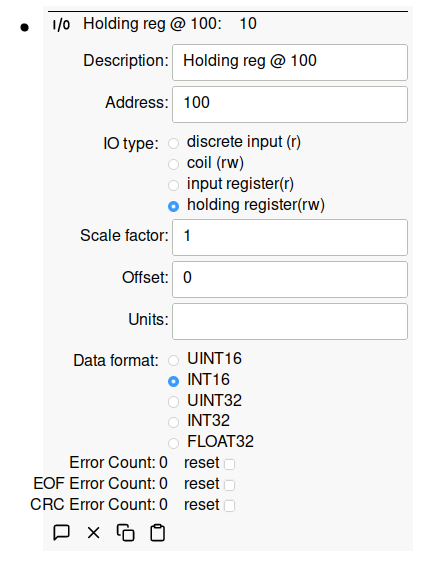

- Modbus commands to send from modbus server serial#
- Modbus commands to send from modbus server full#
- Modbus commands to send from modbus server code#
For example, a device may choose not to implement coils, discrete inputs, or input registers and instead only use holding registers 150 through 175 and 200 through 225.
Modbus commands to send from modbus server full#
The full ranges allowed by the specification are not required to be implemented by a given device. That is, coil 1 is in the coil block at address 0, while holding register 54 is at address 53 in the section of memory that the slave has defined as holding registers. However, each data element is numbered from 1 to n, where n has a maximum value of 65,536. Within the definition of the PDU, Modbus defines the address of each data element as ranging from 0 to 65,535. The specification defines each block as containing an address space of as many as 65,536 (2 16) elements.

The addressing scheme is entirely defined by the slave device, and its interpretation of each memory block is an important part of the device’s data model. For example, coil one may exist in the same location in memory as the first bit of the word represented by holding register one. They may exist as separate memory addresses in a given system, but they may also overlap. These blocks give you the ability to restrict or permit access to different data elements and also to provide simplified mechanisms at the application layer to access different data types. The behavior of each block is described in Table 1. In contrast, Modbus masters must request access to this data through various function codes. The Modbus-accessible data is generally a subset of the device’s main memory. Slave devices have direct access to this data, which is hosted locally on the devices. These data banks define the type and access rights of the contained data. For example, holding registers may be referred to as output registers, and coils may be referred to as digital or discrete outputs. As with much of the specification, the names may vary depending on the industry or application. Modbus-accessible data is stored, in general, in one of four data banks or address ranges: coils, discrete inputs, holding registers, and input registers. Accessing Data in Modbus and the Modbus Data Model The PDU specification defines core concepts for data access and manipulation however, a slave may handle data in a way that is not explicitly defined in the specification.
Modbus commands to send from modbus server code#
Every function code has a specific behavior that slaves can flexibly implement based on their desired application behavior. The size and contents of this data are defined by the function code, and the entire PDU (function code and data) cannot exceed 253 bytes in size. The Modbus PDU format is defined as a function code followed by an associated set of data. This specification defines the format of the PDU, the various data concepts used by the protocol, the use of function codes to access that data, and the specific implementation and restrictions of each function code. The PDU and the code that handles it comprise the core of the Modbus Application Protocol Specification. This led to a separation of the core protocol, which defines the protocol data unit (PDU), and the network layer, which defines the application data unit (ADU).
Modbus commands to send from modbus server serial#
Over time, different application data units were introduced to either change the packet format used over serial or to allow the use of TCP/IP and user datagram protocol (UDP) networks. In the initial implementation, Modbus was a single protocol built on top of serial, so it could not be divided into multiple layers. A Master-Slave Networking Relationship Layers of the Modbus Protocol

The content of these requests and responses, and the network layers across which these messages are sent, are defined by the different layers of the protocol.įigure 1. Typically, the master is a human machine interface (HMI) or Supervisory Control and Data Acquisition (SCADA) system and the slave is a sensor, programmable logic controller (PLC), or programmable automation controller (PAC). In a master-slave relationship, communication always occurs in pairs-one device must initiate a request and then wait for a response-and the initiating device (the master) is responsible for initiating every interaction. Modbus is a request-response protocol implemented using a master-slave relationship.


 0 kommentar(er)
0 kommentar(er)
